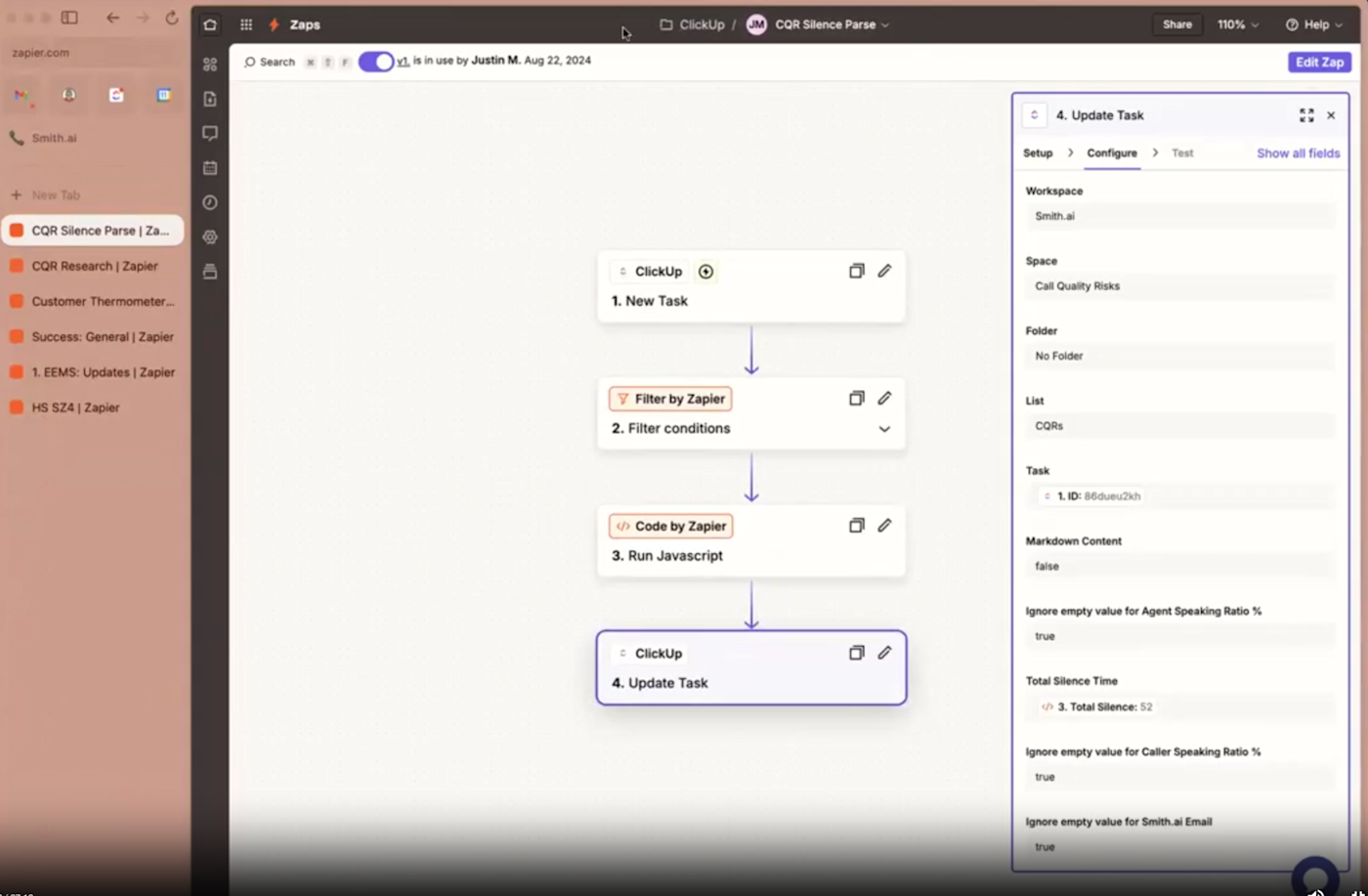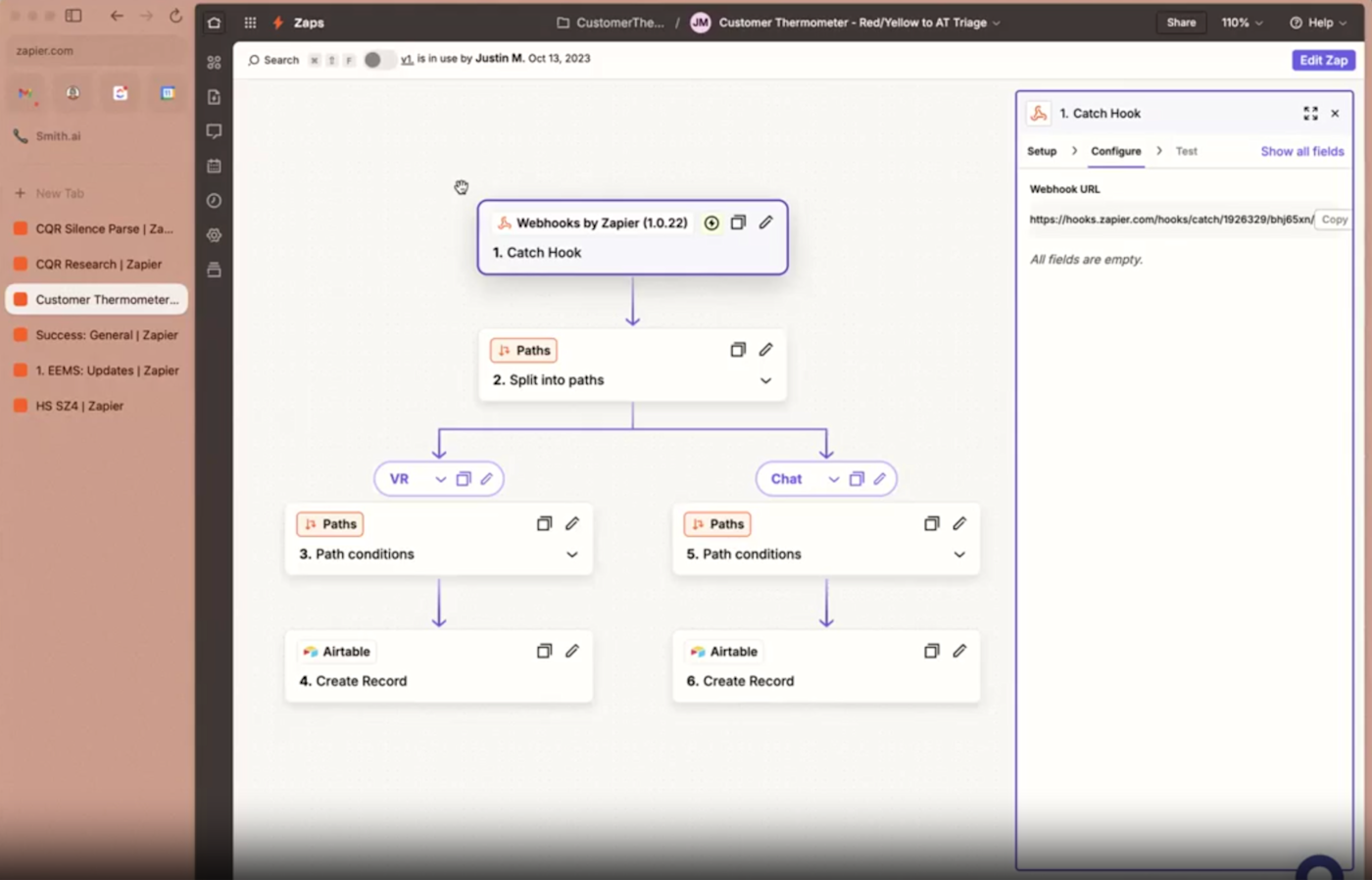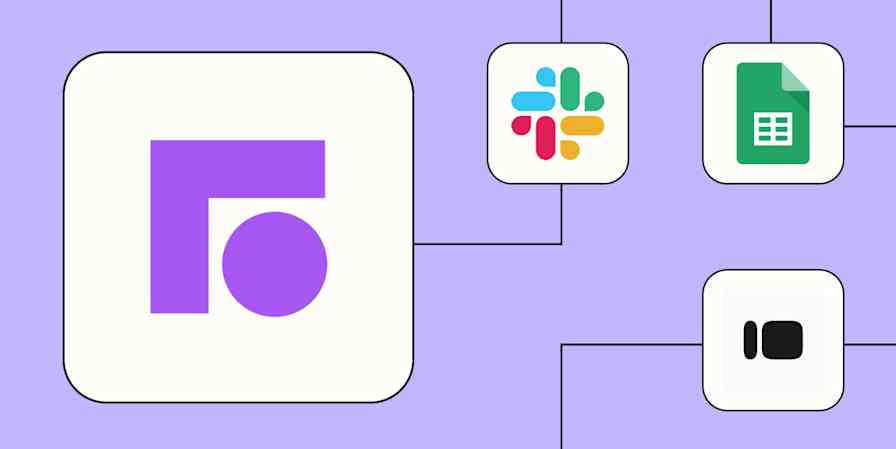When you're handling over a million client conversations across phone, text, and web chat, every second matters. Smith.ai, a virtual receptionist service based in California, knows this well. Their team of receptionists and AI agents serves businesses like law firms and home service providers by answering questions, booking appointments, and qualifying leads, all in real time.
“We’ve grown a lot since our early days,” said Ryan Gough, Principal Solutions Architect at Smith.ai. “Today, AI voice is a big part of our business. But our secret sauce has always been connecting our tools, and our clients’ tools, so everything just works.”
Smith.ai’s high-touch, high-volume model meant they needed scalable, responsive systems to support both agent coaching and customer experience. With a tech stack grounded in ClickUp and Zapier, they’ve built a powerful automation engine that proactively addresses issues, surfaces insights, and keeps quality high.
Smith.ai’s results, by the numbers
Over 1 million calls and chats handled across client verticals
One Zap alone reviews 5,000 calls, saving an estimated 250 hours of manual work each week (more than 10 days straight without stopping)
More than 1,000 Zaps are maintained across two internal Zapier accounts
Hundreds of hours saved per week through proactive triage
Scalable infrastructure supporting hundreds of client workflows
Coaching at scale with call quality monitoring
Handling thousands of calls each day requires consistent quality, especially when Smith.ai’s reputation rests on how well each agent represents a client.
Here’s how the Zap works:
Triggers when a new task is created in ClickUp within the "Call Quality Risks" space.
A Filter step evaluates whether the task qualifies for silence parsing (based on internal logic).
If it passes, a Code by Zapier step runs a custom JavaScript snippet to analyze the call transcription for total silence.
The task is then automatically updated in ClickUp with the calculated silence duration.
This workflow identifies silent gaps in conversations, often signs of confusion or missed prompts, and flags them for coaching. Instead of manually reviewing calls, Smith.ai’s educators get immediate visibility into which calls need attention, allowing them to provide timely, targeted feedback that improves agent performance across the board.

Proactive triage with real-time customer feedback
Client feedback is gold, but only if you can act on it fast. For Smith.ai, every call summary email includes a customer satisfaction survey powered by Customer Thermometer. A red or yellow rating triggers an instant response.
Here’s how the Zap works:
A Webhooks by Zapier trigger catches incoming feedback tagged red or yellow from Customer Thermometer.
A Paths step splits the workflow based on which product the feedback relates to—Virtual Receptionist (VR) or Chat.
Each branch contains a secondary Path step to apply more detailed routing logic.
If the criteria are met, the Zap creates a new record in Airtable under the corresponding team’s triage system.
The result: fast, product-specific follow-up from the right team. Whether the issue is with a virtual receptionist or a human-backed chat interaction, feedback is instantly captured and routed with no delays.
Smith.ai further iterated on this workflow by incorporating a Slack step. Now, feedback is routed in real-time to the correct Slack channel and manager, allowing the team to follow up immediately.
"The speed at which we can collect feedback ensures that customers know how serious we are about proactively updating their account and makes for a fantastic customer experience," said Ryan. "It's a simple but critical automation that ensures nothing slips through the cracks, allowing the team to address client concerns before they even reach out."

Streamlining internal updates and dashboards
As Smith.ai scaled, so did the complexity of its internal updates. The team needed a clean way to route update tasks and categorize requests for both dashboards and manual systems.
Here’s how the Zap works:
Triggered when a new update is created in ClickUp.
A Code by Zapier step identifies the service type tied to the update.
A Paths step then branches logic based on whether the request relates to a dashboard or not.
Dashboard requests are routed directly to Google Sheets to populate a tracking spreadsheet.
Non-dashboard requests go through an additional ClickUp search step to match the most recent relevant task before also logging to Google Sheets.
Since replacing manual categorization with automation, the team has ensured data consistency and minimized time spent managing internal updates. With AI, they’ve also replaced code steps for some of this transformation, enabling more team members, regardless of their technical background, to maintain the system using natural language instructions.

Unifying operations with powerful sub-Zaps
With hundreds of workflows powering internal and client-facing systems, keeping everything organized is critical. Smith.ai uses sub-Zaps to modularize their processes and ensure everything, from task updates to scoring logic, is reusable and consistent.
Here’s how the Zap works:
A Sub-Zap by Zapier step kicks off the workflow.
A value is pulled from a dynamic list using Storage by Zapier.
Data is passed through another Sub-Zap, which returns contextual results.
A Looping by Zapier step converts a text list into repeatable chunks.
A Code by Zapier step performs deeper logic transformations.
The workflow then branches using Paths to determine whether to update an existing task or create a new one.
Each branch routes through additional logic and either updates or creates a task in ClickUp, sometimes applying more JavaScript processing.
By chaining Sub-Zaps, loops, code, and conditions together, Smith.ai ensures its workflows stay modular, maintainable, and highly customizable. This pattern allows it to adapt quickly to new requirements without reinventing the wheel each time, while keeping visibility high across the organization and easily surfacing patterns like upgrades, downgrades, and failed payments.
Scaling with confidence through reliable automation
For Ryan, the future of automation is about simplicity, speed, and confidence. “Zapier is like the IBM of automation. If it’s going to be anywhere, it’ll be on Zapier.” That reliability is what allows Smith.ai to build fast, experiment often, and trust that their systems will scale as they grow.
Automation is now embedded in Smith.ai’s culture, from agent coaching to customer feedback loops and internal operations. By leveraging AI and flexible workflow design, they’re not just solving today’s challenges but also creating a foundation for smarter service tomorrow.
That’s why we can’t live without Zapier. It allows us to move fast, adapt fast, and keep our clients happy.
Ryan Gough, Principal Solutions Architect
About Smith.ai:
Location: Los Altos, California
Industry: IT Services and IT Consulting
Company size: ~280 employees










